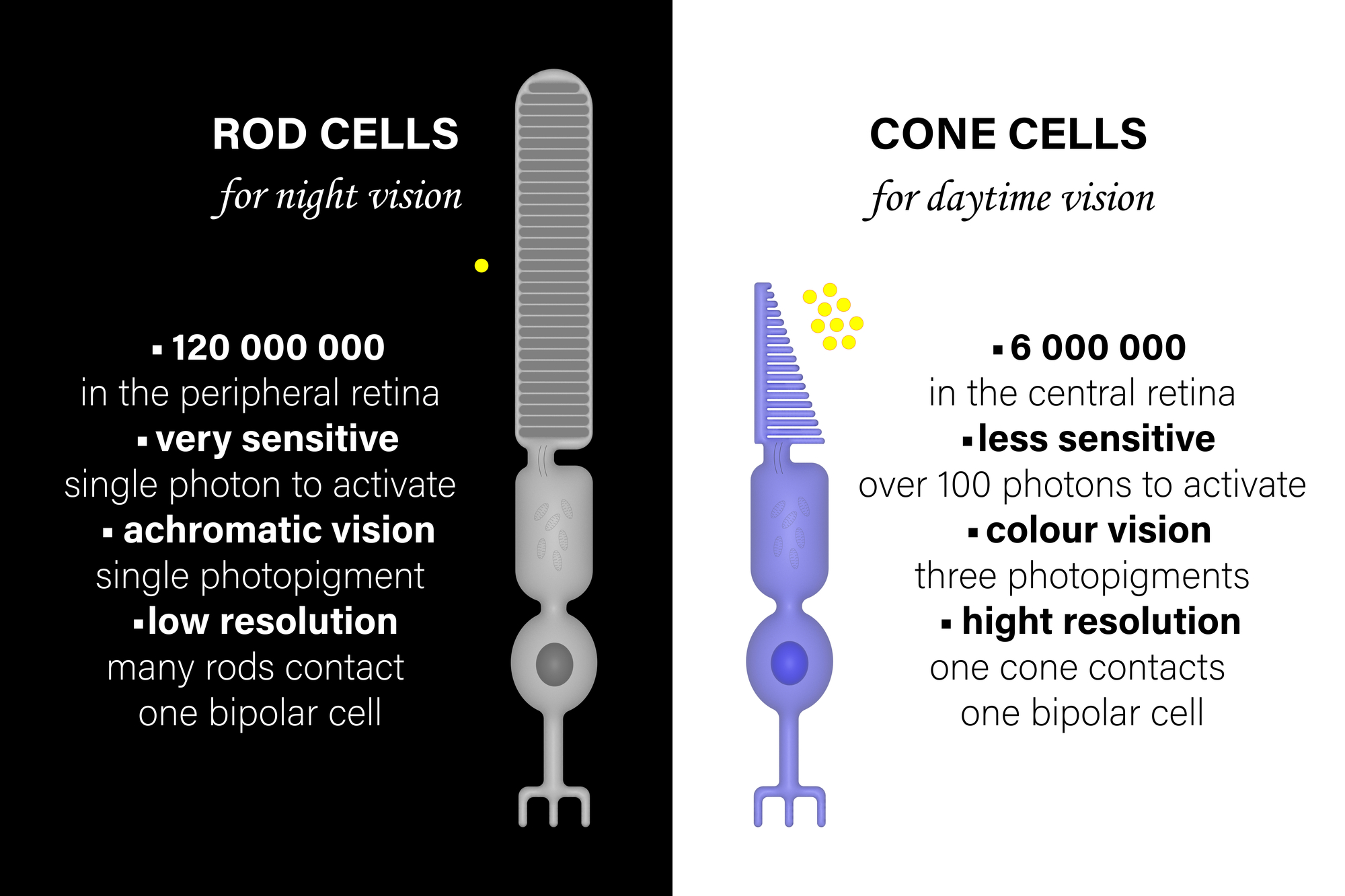Updated on October 9, 2024
What Are Photoreceptors?


Vision Center is funded by our readers. We may earn commissions if you purchase something via one of our links.
Photoreceptors are cells in the retina that detect light and affect color perception. The retina is the light-sensitive part at the back of the eye.
There are two photoreceptor types: rods and cones. Signals from these photoreceptors are sent to the brain for processing via the optic nerve. The optic nerve is a bundle of nerve fibers that connects each eye’s retina to the brain.1
There are more rod photoreceptors than cone photoreceptors in a typical human eye (120 million rods and 6 million cone photoreceptors).
Anatomy and Functions
Photoreceptors are made up of different proteins and function differently. They're located at the back of the retina near the retinal pigment epithelium (RPE), an essential layer for the photoreceptor cells’ survival.2

The cone photoreceptors enable vision in bright light, while the rod photoreceptors help with night vision.
Cone Photoreceptors
Cone photoreceptors are conical-shaped cells made of proteins called photopsins (cone opsins). They make it possible to see multiple colors when looking at surrounding objects.
There are three types of cones named according to their color: blue (10%), red (60%), and green (30%).3 Cone cells are more prevalent in the macula, the part of the retina responsible for central vision.
Cone photoreceptors are sensitive to light at various wavelengths. For example, the red cones activate in red light or when looking at red-colored objects. The same applies to blue and green cones.
If an object has a color other than the primary red, green, and blue cone colors, different cones will activate to produce the object's color. For example, the red, green, and blue cones mix to produce white when looking at a white vehicle. Yellow, however, is created by a mix of green and red cones.
Rods Photoreceptors
Rods are cylindrical-shaped cells made of a protein called rhodopsin (visual purple).4 This protein enables pigmentation in low-light environments (scotopic vision). However, rods do not help with color visualization. This is why determining an object's color in a dim-lit room is difficult.
Rods are more abundant in the outer segments of the retina but not in the fovea, the central part of the macula that's dominated by cones for sharper vision.
Importance of Photoreceptors

Photoreceptors are a crucial part of vision. Here’s why each photoreceptor cell is important:
Night Vision
Rods help us see better in dim light. At night, rods are more active than cones and provide low vision levels. Without rods, we wouldn't be able to function properly at night. This is important for driving at night or seeing objects in the dark.
Color Vision
Cone cells help us distinguish different colors and perceive bright light. For instance, if you look at a red apple, the cones in your eyes will detect the red light. Without cones, you couldn't distinguish colors or see in bright light.
Contrast and Depth Perception
Rods and cones work together to help us perceive contrast. Contrast perception helps us see the difference in light intensity between objects. Depth perception allows us to determine how far away one object is from another.
Contrast and depth perception are important in determining an object’s texture and distance. They also help distinguish people’s faces.
Peripheral Vision
Rod cells also provide us with peripheral vision. Peripheral vision helps us detect objects and motion at the edges of our field of vision. This is important for activities like driving, playing sports, and walking around.
Related Vision Conditions and Treatments
There are various vision conditions associated with photoreceptors. They include:
1. Retinitis Pigmentosa (RP)
Retinitis pigmentosa is a genetic condition that makes the photoreceptor cells break down over time, resulting in vision loss.5 Symptoms of RP usually begin in childhood.
Causes
RP is linked to genetic changes in the retina. Parents can pass down these changes to their children.
Symptoms
- Night blindness (earliest symptom)
- Loss of peripheral vision (side vision)
- Light sensitivity
- Loss of color vision
Some people with RP may lose their vision faster than others. However, most people with this condition eventually lose their peripheral and central vision.
Treatment
There's no cure for RP, but a doctor can prescribe vision aids and rehabilitation programs to manage it.
Talk to your doctor about supplements for RP. Research shows that age-adjusted doses of vitamin A can slow down vision loss in people with RP.6 Lutein and fish oil supplements have also been proven helpful.7
New medications and therapies are under investigation.
2. Color Blindness
Also referred to as color vision deficiency, color blindness is the decreased ability to identify color.8 This can impair tasks such as reading traffic lights or choosing clothes.
Causes
Color blindness occurs if one of the color photoreceptors is absent or dysfunctional. If all cone photoreceptors are missing, complete color blindness occurs. This is rare.
Color blindness is mostly congenital, meaning most people with this color deficiency are born with it. Research shows that men are more likely to have color blindness than women.9
Other causes include:
- Eye diseases, such as glaucoma or macular degeneration
- Eye or brain trauma
- Toxic effects of drugs, such as Plaquenil (for rheumatoid arthritis)
- Metabolic or vascular disease
Symptoms
Symptoms of color blindness may range from mild to severe. People with mild color blindness can see colors in normal light but not as well in dim light. Many people are unaware that they have the condition. Symptoms include:
- Difficulty seeing colors and their brightness
- Inability to tell the difference between colors (common with red, blue, yellow, and green)
People with complete color blindness see no color (objects appear in shades of gray). This rare condition is known as complete achromatopsia. Symptoms include:
- Amblyopia (lazy eye)
- Poor vision
- Nystagmus (rapid or uncontrollable eye movements)10
- Light sensitivity
Treatment
There's no treatment for color blindness, especially if you're born with it. However, an eye doctor can prescribe special eye lenses or sunglasses to improve vision. A doctor will address the acquired forms of color blindness by treating the underlying condition.
3. Photokeratitis
Photokeratitis (sunburned eyes) is a temporary but painful condition caused by overexposure to ultraviolet (UV) rays from the sun or an artificial source. When your eye is exposed to UV rays, your retina can get sunburned, causing damage to photoreceptors.
Causes
Photokeratitis can result from directly staring at the sun. It can also result from staring at the sun's reflection from snow (snow blindness), sand, or water. Eye experts also believe that staring directly at a solar eclipse without special glasses can cause a retinal burn (solar retinopathy).11
Artificial sources of UV light, such as arc welding and tanning lamps, are also significant causes of photokeratitis.
Symptoms
- Eye pain
- Red eyes
- Blurry vision
- Halos around lights
- Excess tearing
- Gritty feeling in the eyes
- Swelling
- Headache
- Sensitivity to bright light
- Eyelid twitching
- Temporary vision loss (rare)
Treatment
Photokeratitis usually goes away on its own.
Any offered treatment aims to help the healing process. Doctors recommend not wearing contact lenses and staying away from direct sunlight.
Your doctor may also recommend:
- Cold compresses (placing a cold, wet washcloth over the affected eye)
- Taking pain relievers (as recommended)
- Using eye drop antibiotics to prevent infection
- Avoiding rubbing your eyes until you fully recover
4. Usher Syndrome (Hallgren Syndrome)
Usher syndrome is a rare disorder that causes hearing and vision loss. It can also cause balance issues.
Usher syndrome is often associated with retinitis pigmentosa (RP). Most people who have RP were born with it.
There are three types of Usher syndrome:
- Type 1. Severe hearing loss or deafness at birth, loss of night vision by age 10, and balance problems.
- Type 2. Moderate to severe hearing loss from childhood and loss of night vision by teenage years that worsens over time.
- Type 3. Normal hearing at birth that deteriorates in childhood and loss of night vision by teenage years that worsens over time.
Causes
Usher syndrome is caused by genetic changes and is passed down from parents to children. Current research points out nine genes responsible for this condition.12
You can develop Usher syndrome if you inherit two copies of an abnormal gene (one from each parent).
Hearing loss in Usher syndrome is linked to abnormal growth of hair cells (sound receptor cells) inside the ear.
Symptoms
The symptoms of Usher syndrome depend on the type. However, everyone with Usher syndrome develops retinitis pigmentosa (RP).13 Other symptoms include:
- Hearing loss or deafness and RP
- Loss of night vision and side vision (peripheral vision)
- Light sensitivity
- Loss of color vision
Treatment
Usher syndrome has no standard cure. However, early detection and quality treatment can slow down the progression of disease symptoms, such as hearing loss.
Notify your doctor immediately if you notice any of the above signs of Usher syndrome.
Diagnosing Conditions Related to Photoreceptors
Here are some of the most common techniques doctors use to diagnose conditions related to photoreceptors:
Electroretinography
An electroretinography (ERG) test is also known as an electroretinogram. It's a procedure that measures the electrical response of the light-sensitive cells in the eyes.
During this test, your doctor will first numb the eye using eye drops. Then, they will use an electrode to measure the electrical response of the rods and cones in your eyes.
Optoretinography (ORG)
Optoretinography (ORG) is a test that records optic signals. It also measures the light-induced functional activity in the retina, which includes the rods and cones.
Optical Coherence Tomography (OCT)
Optical coherence tomography (OCT) is a non-invasive test that allows your doctor to map and measure the retina’s thickness. During the treatment, your doctor will use dilating eye drops to widen and examine your retina.
Summary
Photoreceptors are special cells located at the back of the retina, near the retinal pigment epithelium. They exist in two types: cone photoreceptors (cones) and rod photoreceptors (rods).
Cones are conical-shaped and made up of proteins called photopsins (cone opsins), which enable pigmentation in the eye in bright light. Rods are cylindrical and made up of a protein called rhodopsin (visual purple), enabling pigmentation in low-light environments.
There are more rod photoreceptors than cone photoreceptors in a normal human eye (120 million rods and 6 million cone photoreceptors).
Diseases affecting photoreceptors include retinitis pigmentosa (RP), color blindness, photokeratitis, and Usher syndrome. Most of these conditions have no cure, but various interventions exist to manage disease progression.
In this article
13 sources cited
Updated on October 9, 2024
Updated on October 9, 2024
About Our Contributors
Vincent Ayaga is a medical researcher and seasoned content writer with a bachelor's degree in Medical Microbiology. Specializing in disease investigation, prevention, and control, Vincent is dedicated to raising awareness about visual problems and the latest evidence-based solutions in ophthalmology. He strongly believes in the transformative power of ophthalmic education through research to inform and educate those seeking knowledge in eye health.
Dr. Melody Huang is an optometrist and freelance health writer with a passion for educating people about eye health. With her unique blend of clinical expertise and writing skills, Dr. Huang seeks to guide individuals towards healthier and happier lives. Her interests extend to Eastern medicine and integrative healthcare approaches. Outside of work, she enjoys exploring new skincare products, experimenting with food recipes, and spending time with her adopted cats.

